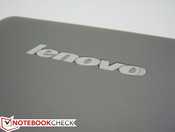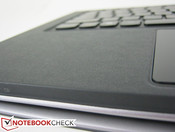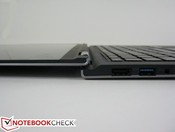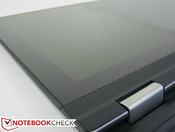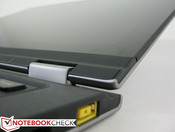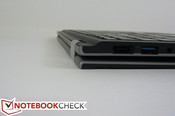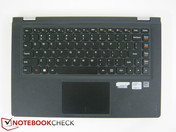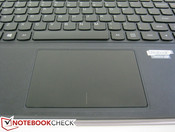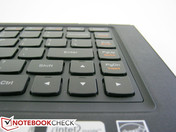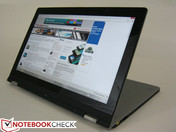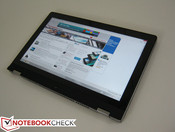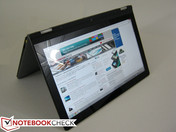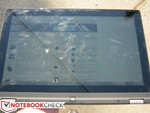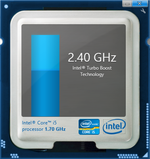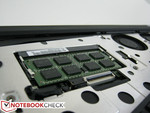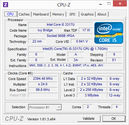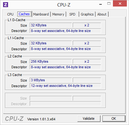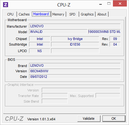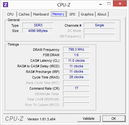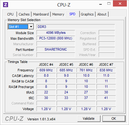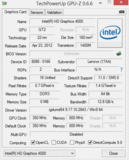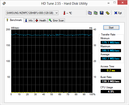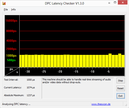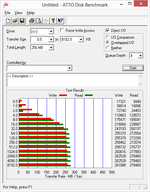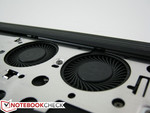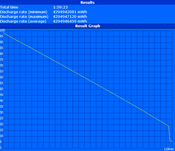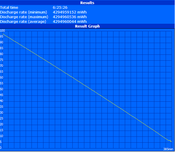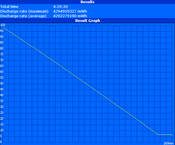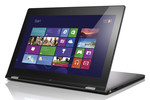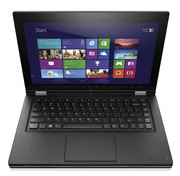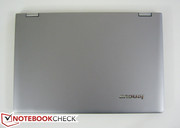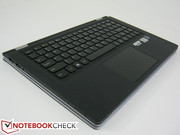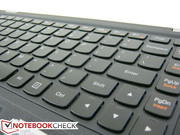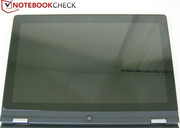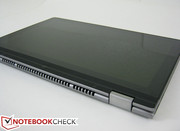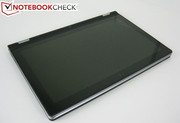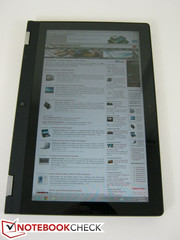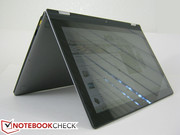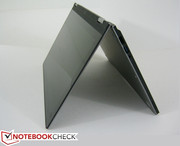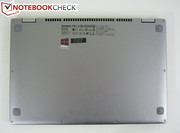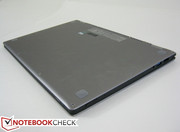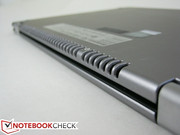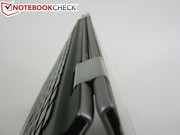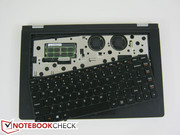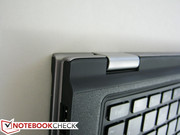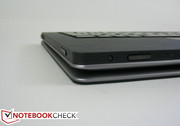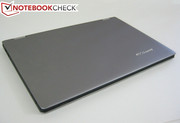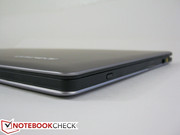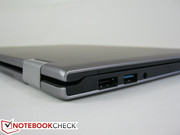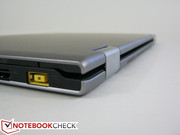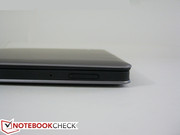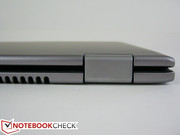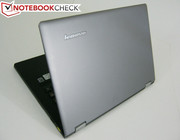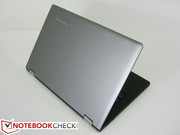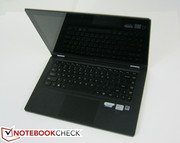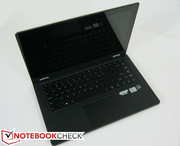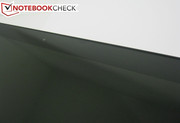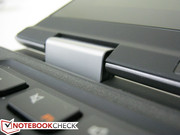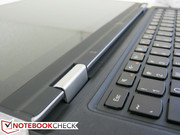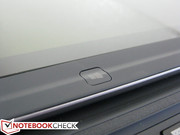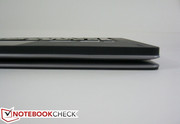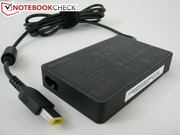Review Lenovo IdeaPad Yoga 13 Ultrabook

Unveiled at CES 2011 and further demoed at a number of following trade shows since, the IdeaPad Yoga has generated perhaps more attention from the general media than any other Lenovo release this year. Its alluring name and full swing of the touchscreen display have gotten consumers curious about the quality, functionality and usability of the Windows 8-specific hardware. While the notebook/tablet hybrid concept is not new (see Dell XPS 12, Fujitsu Lifebook T901, ThinkPad X220T/X230T and related T models), the swivel-free hinges of the Yoga is a first for a Lenovo convertible. The notebook certainly stands out from the crowd of “typical” Ultrabooks, but is the uniqueness of this hybrid enough to warrant a purchase over its competitors?
In this review, we take a closer look at the Yoga 13, Lenovo’s 13.3-inch convertible equipped with a 1.7 GHz Core i5-3317U CPU, 4 GB RAM, 128 GB SSD, 1600x900 resolution IPS display, and integrated HD 4000 graphics. The current configuration is available for $1099 in the U.S. (resellers may have it for $100 less) and can be pre-configured with select Core i7 CPUs and up to twice the SSD storage size as needed. A smaller, ARM-based Yoga 11 running Windows RT is set for launch before the end of this year. We subject the Yoga 13 to our usual measurements and benchmarks below to see if the actual hardware is as impressive as it is eye-catching.
Case
At its closed position, the Yoga 13 closely resembles the IdeaPad U300s, a 2011 Lenovo Ultrabook that we praised for its design and quality. The matte silver lid and underside sandwiches the inner black case in a similar manner as the U300s. Nonetheless, the Yoga 13 is actually slightly thicker (16.9 mm vs. 14.9 mm) with a hard black base and inner display bezel. The chassis is matte on all areas, but with a distinct glossy display and surrounding edge-to-edge bezel that mimics the face of a typical tablet. Build material is plastic all around, but the manufacturer has avoided the “cheap plastic” feel by giving every surface (sans the display) a soft, faux leather texture that is especially evident on the palm rest areas. This unexpectedly makes the Yoga 13 feel and look more expensive than the U300s even if the core build materials are alike. A trivial disadvantage is that fingerprints build up easily and can be difficult to clean due to the texture.
What users will notice first-hand is the weight. At about 1.55 kg, the Yoga 13 is one of the heavier 13-inch Ultrabooks. The convertible is around 100 to 200 grams heftier than competitors like the HP Spectre XT 13, Dell XPS 13, and Zenbook UX32A and almost 400 grams more than the super-thin Samsung 900X3B Series 9. In this case, the price of versatility is a slightly thicker, slightly weightier chassis.
The Yoga 13 was built to be adaptable by way of multiple interchangeable forms. Because of this, it is vital that build quality be solid enough to withstand more relentless inputs, twists, and rotations than a regular notebook. Thankfully, the Yoga delivers on these fronts. Applying pressure on any surface results in minimal depression as the chassis is quite dense all around. The center of the keyboard and outer lid are more easily warped with a firm press of a finger, but this is common with most notebooks and other IdeaPads. Resistance to side-to-side twisting of the base is good but not the best as some bending can be observed. The same can be said of the lid, though the amount of twisting is minimal enough for both cases that build quality is not largely affected.
The hinges can either make or break the notebook as the Yoga’s ability to transform rests on the rigidity and durability of the pivot points. We’re relieved to say that the hinges are sufficiently strong to prevent any unintended display movements that would otherwise occur while transporting the notebook with the lid at a wide angle. The amount of force it takes to move the lid is also consistent from degree to degree, so users should not have to worry about the hinges becoming weaker at certain angles than others. Note that the display can still vibrate slightly if working in an unsteady environment, such as a car or bus. Luckily, magnets secure the display in place to prevent any shaking when in tablet mode. Although not the most rigid hinges we’ve seen, they are firm enough to get the job done and are surprisingly good in spite of their diminutive sizes.
Connectivity
The amount of available ports is average for an Ultrabook, meaning users shouldn’t expect too much. Since the rear is completely reserved for the hinges and ventilation, all ports are located on the left- and right-hand edges towards the rear to mitigate potentially annoying cables blocking valuable space for left- and right-handed users. The core concept of the Yoga disallows ports on the rear anyway, so side ports are to be expected.
Sharing space with the ports above are several buttons commonly found on tablets. A volume rocker, screen lock, and even the power and OneKey Recovery buttons are all located around the edges closest to the user. The buttons, though small relative to the size of the hardware, allow for basic functionality when using the Yoga as a tablet. It would have been handy to include a brightness rocker as well for quick manual brightness adjustments.
We are a little disappointed to see some basic ports missing from the Yoga, namely the Ethernet port and Kensington Lock option. VGA-out, which is still offered on a small handful of Ultrabooks in the form of mini-VGA, is also gone, leaving only an HDMI-out. Also of note are the two USB ports, only one of which is 3.0. Suffice to say, physical connectivity options are limited without external hubs and/or adapters.
Communication
In terms of wireless connectivity, the Yoga 13 offers standard WLAN and Bluetooth with the Realtek RTL8723A mini PCIe adapter. There are no options for GPS or WWAN, nor is there an unoccupied PCI-e slot for such expansions. Those looking for such hardware may find the touchscreen-enabled ThinkPad X series (such as the X220T/X230T) more appealing.
Accessories
Lenovo is never shy when it comes to accessories, but the lack of both a removable battery and dedicated docking port mean that most available accessories will be generic cases, USB 3.0 docking stations and other USB-powered hardware. This is no ThinkPad, of course, and the absence of specialized peripherals should be of no surprise to IdeaPad owners.
At this price range, however, we did expect at least a faux leather or velvet protective sleeve out-of-the-box, similar to what Asus and HP offer with most Zenbook and Envy models, respectively. The notebook is a fingerprint magnet from the top down, so a case of some sort is recommended for traveling.
Warranty
The standard 1-year limited coverage applies if ordered directly from Lenovo.com or from most (if not all) resellers. Alongside Dell, the manufacturer offers one of the more extensive coverage options should the buyer decide for extended warranty with up to two additional years, onsite service (in the U.S.) and/or accidental damage protection for up to an additional $150.
Input Devices
Keyboard
The Chiclet AccuType keyboard that has been taking over the latest ThinkPad models is in full form on the Yoga 13. The layout is appropriately sized (27.5 cm x 10.0 cm) with keys evenly spaced, including the full-size directional keys that are often squished in notebooks of this category. There is no backlight on the Yoga, a feature we were expecting from a notebook at this price range.
The Backspace, Enter, and Shift keys have taken a backseat in terms of size as the lengths are indeed shorter than the corresponding keys found on other notebooks. While this does mean less leeway and potentially more mishits, we did not run into any accuracy problems during normal use. Still, it is possible that some users may need a day or two to adjust to the reduced sizes of these frequently used keys.
Unfortunately, feedback from typing is only average. The shallow travel would have been acceptable if the keys had a solid press or response. Instead, the QWERTY keys are quiet, a bit on the soft side, and not as firm as we would have liked. The space and Enter keys do have better tactile feel, though they are comparatively louder as is typical. As with most keyboards, users will eventually feel comfortable with the impression of the keys overtime.
Touchpad
Compared to traditional ThinkPads, the touchpads on newer IdeaPads are generally flatter, physically smoother, and relatively larger with no surface area dedicated to click keys. On the flip side, IdeaPad touchpads are also usually thinner and more noticeably plastic, leading to a cheaper or budget feel. The touchpad of the Yoga 13 is certainly large and plastic and is indeed very similar to that of the U300s, even sharing the same 10.5 x 7.0 cm dimensions. The new dark color, slight rubber feel, and additional rubber borders all attribute to the updated aesthetics that make it appear more high-end than its U300s counterpart when it reality they function very similarly with regards to responsiveness and consistency.
We encountered no input issues with the touchpad. Controls are handled with the Synaptics V 8.1 software and multi-touch gestures are easy to use because of the large surface area provided. Push-to-click is shallow as one would expect, but the feedback is sound and satisfying enough that we did not find it to be an issue. As with the U300s, grease and fingerprints will accumulate very quickly on the touchpad and can be difficult to completely wipe off.
Touchscreen
Windows 8 includes built-in touch controls as standard and the 10-finger capacitive touchscreen is always operational regardless of the orientation. Switching to tablet form is seamless as well, requiring no additional confirmation outside of simply physically flipping the display over to its position. Compared to a tablet with Gorilla Glass, the protective surface of the display feels thinner and more fragile, so we feel less comfortable tapping on the display as firmly as one would with a tablet. A strong press will depress the immediate screen area, but never by a worrying degree.
While we won’t go too much into detail with Windows 8 and its interaction with touch inputs, we can say that it may take some time getting used to handling the Yoga as a tablet. Unlike the swiveling ThinkPad T models, the keyboard and touchpad are completely exposed underneath. Both are automatically disabled in tablet mode, but the fact that the user will be unavoidably pushing the touchpad and keys underneath can feel a bit odd, especially when we are now habituated to smooth, solid back surfaces of dedicated tablets and smartphones.
The asymmetric qualities of the notebook can also be felt much more clearly when in tablet mode. Because of the center of gravity and positioning of the keyboard, touchpad, and ventilation grilles, certain orientations can be more preferable than others during use. For example, holding the device in portrait mode will result in one hand carrying most of the weight and the other hand becoming fairly warm over time due to the weight differences and active vents, respectively. Gripping the notebook in this fashion is definitely a challenge at first, but we eventually found ourselves becoming comfortable with both portrait and landscape orientations after a few days of consistent use. Given enough time, switching to and fro between the two forms becomes second nature.
Motion Control
Outside of the physical inputs and touchscreen capabilities, Lenovo offers simple motion control by making use of the webcam. Users can flip pages and scroll through music by simply waving a hand over the camera. In practice, the method is unreliable and laggy. The concept would have been useful if the notebook can be controlled from across the room, but the camera does not recognize any inputs from anything more than a few feet away. Wireless and Bluetooth controls are much more practical as the motion sensing is ultimately a brief novelty at best.
Display
The 13.3-inch LG display offers a resolution of 1600x900 pixels, higher than the standard 1366x768 or 1440x900 resolutions as found on many other ultrathins including the Dell XPS 13, HP Spectre XT 13, 2012 MacBook Air 13, and Lenovo’s own IdeaPad U310. The newest generation of Ultrabooks is beginning to include 1080p displays, such as the Asus Zenbook UX21A and Acer Aspire S7, so don’t expect the highest PPI numbers from the Yoga 13.
The edge-to-edge hard-plastic bezel makes screen content appear closer to the surface instead of being buried under protective layers. When combined with the glossy display, the resulting flat look provides very clean and sharp images that pop out, similar to the HP Envy 15 3040nr, especially at maximum brightness. The display not does disappoint from a visual perspective even if it does lack Gorilla Glass protection.
With a Gossen Mavo-Monitor, a maximum brightness of 286 nits was measured on the center quadrant of the screen. The notebook maintains this value regardless of the power plan (i.e., Battery saver, Balanced, and Performance), so users can make use of the full brightness potential if away from an outlet. The overall brightness of the Yoga 13 is above average from the perspective of a notebook, but is only average from a tablet point of view. Contrast is excellent and produces deep blacks enough for movies to be enjoyed without muddy grays.
| |||||||||||||||||||||||||
Brightness Distribution: 87 %
Center on Battery: 286 cd/m²
Contrast: 923:1 (Black: 0.31 cd/m²)
43.84% AdobeRGB 1998 (Argyll 3D)
62.5% sRGB (Argyll 3D)
42.29% Display P3 (Argyll 3D)
Color space reproduction is good at 64 percent of the sRGB standard or a few percentage points better than the usual budget TN panels. Coverage from the panel is similar to that of the U300s, but ultimately falls short compared to the ThinkPad X1 Carbon and the dazzling display of the 13.3-inch 1080p Zenbook UX32VD. As usual, this should only concern professional graphic artists who require paramount color accuracy. If this is desired, the ThinkPad W series would be more fitting as such color accuracy requirements are beyond the scope of the IdeaPad family.
Outdoor usability is generally good, but the maximum brightness setting is highly recommended due to the glossy display; anything lower and glare will become very apparent. Direct sunlight will impair readability by an observable margin and should be avoided especially if shade is within reach. Fortunately, the flexibility of the hinges allow for wider positions for optimal viewing.
The notebook offers 10 levels of screen brightness. Why is this worth noting? The brightness drops to only 160 nits if moving from level 10 to level 9, a decrease of over 120 nits from only a 1 level reduction. While this is acceptable for indoor use, we found anything below level 9 or 8 to be uncomfortable for outdoor use.
Viewing angle stability is excellent as expected from an IPS panel. There are no observable color inversions and minimal relative brightness reductions from obtuse angles. Sharing content with nearby viewers is easily feasible with the notebook regardless of its current orientation. In short, the display of the Yoga 13 visually impresses and is indubitably more vibrant and sharper than TN-based Ultrabooks.
Performance
Our model in review is equipped with the middle-of-the-road third generation 1.7 GHz Core i5-3317U. On Balanced or Energy Saver mode, both cores idle at 800 MHz. Two other ULV Ivy Bridge CPUs are available, the i3-3217U and i7-3517U, with no standard-voltage or Sandy Bridge options in sight. This particular i5 processor is now common amongst Ultrabooks and ultrathins, including the Toshiba Satellite Z930, Samsung Series 9 models, Aspire models and the MacBook Air 11. The 17 W CPU is rated at about half the TDP of its standard-voltage counterparts and should be more than enough for everyday browsing or video playback needs. More information and benchmarks on the i5-3317U can be found on our dedicated CPU section here.
For RAM, the Yoga 13 under review is equipped with a 4 GB DDR3 PC3-12800 SODIMM module from Micron Technologies. The RAM and SSD are both user-removable, though there is only one slot total for the memory. Exposing the hardware is not as simple as removing a couple of screws underneath as the user must first detach the keyboard and several subsequent screws before any sort of upgrading is possible. A hex wrench (Allen key) is required, further thwarting end-user upgradability. We do, however, appreciate the fact that the modules are removable and not soldered, unlike a number of other Ultrabooks in the market.
DPC Latency Checker shows no recurring high latency peaks or spikes even with wireless radios active.
Processor
The synthetic CPU-oriented benchmarks rank the Yoga about average with other Ultrabooks with the same CPU, if not a little lower. For example, the similarly equipped Spectre XT 13 and Samsung 530U3C Series 5 both score at least 10-20 percent higher than the Lenovo in CineBench 64 Bit CPU tests and the multi-core wPrime tests. This may be due to the poor Turbo Boost stamina of the processor in the Yoga as discussed in the stress test below. Compared to Sandy Bridge processors, the i5-3317U provides tangible benefits over the i3-2310M and is comparable to the common i5-2410M. The latter is noteworthy because the Ivy Bridge i5-3317U achieves a similar level of processing power at half the TDP of the Sandy Bridge i5.
System Performance
PCMark 7 was used to assess general system performance. At about 4396 points, the notebook is again bested by the similarly-equipped Spectre XT 13 by about 20 percent and a few hundred points below that of the ThinkPad Carbon X1. The differences may be explained by the SATA II SSD and limited Turbo Boost potential as discussed in the sections below. This is by no means a bad score as it is still significantly greater than notebooks without dedicated SSDs. The Zenbook UX32VD, for example only returned 1934 points in the same benchmark because of its hybrid HDD/SSD setup. Thanks largely to the SSD, day-to-day activities feel instantaneous on the Yoga.
At the time of writing, PCMark Vantage was incompatible with Windows 8. Instead, we provide the Windows 8 Experience Index results below for reference. Note that the new Experience Index is scaled differently than that of Windows 7, so Experience Index numbers between the two operating systems should not be compared directly.
| PCMark 7 Score | 4396 points | |
Help | ||
Storage Devices
At the bare minimum, the Yoga 13 is equipped with a 128 GB mSATA SSD and is configurable up to 256 GB. Our model houses a removable 128 GB SATA III mSATA SSD from Samsung and is the same model as the one found on the Spectre XT 13. We expect to have very similar benchmark numbers as a result, when in reality the numbers on the Yoga 13 are lower across the board according to CDM, AS SSD, and ATTO. The final numbers are akin to a SATA II drive even though the Samsung SSD itself is SATA III capable, meaning it is entirely possible that the actual interface on the board is only compatible up to SATA II speeds (confirmed by Lenovo here). Though by no means a slouch, it is disheartening to know that users may not be getting the full benefits of a SATA III SSD in the Yoga 13.
Of the 119.12 GB of space available, 20 GB is reserved for system recovery, leaving about 88.8 GB free for Windows 8 and the user. See here for our growing list of benchmarked HDDs and SSDs.
Graphics Card
Results from the synthetic GPU-oriented benchmarks appear underwhelming. The integrated HD 4000 GPU is capable of Turbo Boost up to 1050 MHz, but is more than likely to run closer to 500 MHz during 3D gaming sessions. ULV processors like the i5-3317U get the short end of the stick with regards to the integrated graphics core as other standard-voltage Ivy Bridge CPUs have the same HD 4000 GPU capable of higher clock rates up to 650 MHz or 1100 MHz with Turbo Boost.
The slow GPU is evident while running Starcraft 2. The average HD 4000 should run the title at about 110 FPS and 25 FPS on Low and Medium settings, respectively, according to our benchmarks. The Yoga 13 runs the title at half these frame rates and similarly as low on Guild Wars 2. With no dedicated GPU options, 3D gaming is definitely not a strong point with the Yoga 13. More information and benchmarks on the Intel HD 4000 GPU can be found in our dedicated review here.
To test if system performance will remain the same on battery compared to AC adapter power, we ran 3DMark06 on battery power and recorded any potential changes. The final scores showed negligible differences between AC power and battery power.
| 3DMark 03 Standard | 9036 points | |
| 3DMark 05 Standard | 6871 points | |
| 3DMark 06 Standard Score | 4368 points | |
| 3DMark Vantage P Result | 2620 points | |
| 3DMark 11 Performance | 573 points | |
Help | ||
| low | med. | high | ultra | |
|---|---|---|---|---|
| StarCraft 2 (2010) | 64.1 | 12.6 | 8.9 | |
| Guild Wars 2 (2012) | 17.9 | 5.8 |
Emissions
System Noise
The Yoga 13 produces audible noise from its dual fans even when idle, leading to a notebook that is never completely silent and a little louder than other Ultrabooks. Still, noise level increases only slightly under medium load and never becomes an annoyance. Ambient sounds from the home or office can easily drown out the fan noise, which is only distinctive under quiet circumstances.
At about 38 dB(A), fan noise under load becomes very obvious, but not high-pitched enough to become irritating. This noise level is very close to what other Ultrabooks at maximum load can produce and should not be an issue during regular use. For example, we were only able to reproduce the measured load values with full system stress benchmarks and not during browsing or gaming sessions.
Noise level
| Idle |
| 34.7 / 34.9 / 34.9 dB(A) |
| Load |
| 35.6 / 38.2 dB(A) |
 | ||
30 dB silent 40 dB(A) audible 50 dB(A) loud |
||
min: | ||
Temperature
Surface temperatures in the idle state are relatively cool and uniform on both the keyboard side and underside. Of note are the top left corner and the corresponding corner underneath, which are prominently warmer at about 32 degrees C each. When fully stressed, these hotspots became very warm at over 40 degrees C. In comparison, other areas of the notebook increased by only a few degrees, resulting in a modestly warm notebook as most of the produced heat is concentrated quite well towards the rear and corner. Most importantly, the front areas where the palms and lap are more likely to contact stay quite cool regardless of system load.
The load measurements below were reproduced with Prime95 and FurMark running simultaneously for over an hour and are thus not a perfect representation of typical surface temperatures during browsing or word processing. As such, we don’t expect users to run into uncomfortable surface temperatures during everyday use with the Yoga 13 based on our maximum temperature readings.
(±) The maximum temperature on the upper side is 40.2 °C / 104 F, compared to the average of 35.4 °C / 96 F, ranging from 19.6 to 60 °C for the class Convertible.
(±) The bottom heats up to a maximum of 41.6 °C / 107 F, compared to the average of 36.8 °C / 98 F
(+) In idle usage, the average temperature for the upper side is 26.8 °C / 80 F, compared to the device average of 30.3 °C / 87 F.
(+) The palmrests and touchpad are cooler than skin temperature with a maximum of 26.8 °C / 80.2 F and are therefore cool to the touch.
(±) The average temperature of the palmrest area of similar devices was 27.9 °C / 82.2 F (+1.1 °C / 2 F).
Stress Test
Prime95 and FurMark were utilized to simulate stressed condition first independently and then simultaneously while monitoring CPU/GPU status with various tools.
We stressed the processor with Prime95 and noted any fluctuations in CPU speed. Under the High Performance setting, both cores idled at their advertised 2.4 GHz Turbo Boost speeds according to HWiNFO. This quickly dropped to a more stable 1800-1900 MHz range after initiating the benchmark, suggesting that the processor cannot sustain its Turbo Boost speed for even a considerable duration when under load.
The integrated GPU was then stressed with FurMark and monitored with GPU-Z. Similar to the CPU, the GPU Turbo Boost (1050 MHz) was only in effect for the first several seconds of the test and eventually leveled off at the 400-550 MHz range.
Under full stress from both Prime95 and FurMark, both CPU and GPU speeds were observed to be operating at their respective minimums of 800 MHz and 350 MHz. These speeds are essentially the idling states when in Power Saver mode. We ran 3DMark06 immediately following the stress test, which revealed a lower final score of 3206 points compared to the 4000+ points prior to the stress test. Throttling is thus a possibility under high enough workloads and conditions.
It may be worth noting that core temperature was only about 62 degrees C during maximum stress and that the GPU load was seen fluctuating between 85 and 100 percent during the same test. This suggests that throttling was likely not due to any overheating issues and may be more related to power or current bottlenecks of the hardware itself.
Speakers
The Yoga 13 includes built-in stereo speakers each operating at 1 W. The location of these speakers are unique in that they emanate from the crevices underneath the Chiclet keys instead of through dedicated speaker grilles as found on most other notebooks. More specifically, the left and right speakers are located beneath the “Caps Lock” and “L” keys, respectively. The positioning is not entirely symmetrical down the center of the notebook, but this fortunately has no negative impact on balance.
Sound quality is good considering the size, but not the best in its class as we found that the similarly-sized Samsung 900X3B can produce comparatively clearer acoustics. Sounds are a bit muffled overall and the forward-facing speakers mean that audio will be emitting towards the opposite direction of the user when in tablet mode. On the bright side, the speakers have evaded the “tinny” quality that plagues most cheap notebooks and tablets and the drawbacks are countered somewhat by the loud volume and subjectively distortion-free bass and treble balance. We found ourselves satisfied at even below 50 percent volume in most cases. Though external speakers are best, the built-in solution should be more than satisfactory for everyday music and video use.
Battery Life
We put the convertible through our usual tests with Battery Eater to record. For the maximum runtime idle test, the notebook was set to its lowest brightness on Energy Saver mode with wireless radios and all timeouts disabled. The battery was able to last for almost 6 hours and 30 minutes under these settings.
Minimum runtime was performed at maximum brightness, wireless radios active and on the Performance profile. With the Battery Eater Classic Test, the notebook was able to last for about 2 hours before automatic shutdown.
The more realistic WLAN test involves subjecting the notebook to our standardized looping script to simulate internet browsing conditions and short Flash videos. With brightness close to 150 cd/m (9/10 setting) and on the Balanced profile, the notebook was able to last for about 4 hours and 30 minutes.
According to Battery Eater, the non-removable lithium-Polymer battery provides 54.7 Wh of power similar to that of the U300s. In fact, total runtimes are fairly comparable between the U300s and Yoga 13. Lenovo again claims up to 8 hours of battery runtime, something that we were unable to reproduce without resorting to turning the display off completely. A more realistic runtime would be 4-5 hours on a full charge, which puts the Yoga 13 in line with most other Ultrabooks and above a few battery underperformers (i.e., ThinkPad X1 Carbon and LifeBook UH572) as well. Still, we feel that battery life can be slightly underwhelming overall as its capacity itself is larger than the more typical 40 to 50 Wh modules on the majority of other Ultrabooks.
Verdict
The Yoga 13 is both a cautious and valiant effort at introducing a unique, yet ThinkPad X220T-like experience for the first time to IdeaPad users. The patented hinges are more than a novelty and the tablet functionality works wonders after acclimating to the uneven weight distribution. It’s not as easy to pick up and play as with a tablet, but the duality and versatility of the Yoga combined with Windows 8 make the convertible leagues beyond what any available dedicated tablet can offer.
On the hardware front, the Yoga has one of the sleekest designs and form factors for an IdeaPad to date. Build quality is better than expected with no overly plastic textures that can normally make an expensive notebook feel cheap. It’s clear that some girth and weight have been added in order to incorporate the touchscreen, which may turn off some users who prefer thinner and lighter Ultrabooks. The keyboard could have provided more feedback and travel as well and the small Backspace and Enter keys may take some time to get used to. Luckily, arguably the most important piece of the hardware – the hinges – are far from weak and do a fantastic job at holding the display relatively stable on its multiple modes.
Those who have no interest in the tablet form may want to opt for a lighter, thinner, and more portable Ultrabook for around the same price or even less. For example, similar battery life expectations and likely better system performance can be had with the HP Spectre XT, Samsung Series 9, or Acer Aspire S5. Even so, the Yoga 13 is aggressively priced and is ultimately a fresh, well-designed hybrid that is both fun to use and practical all at once.




